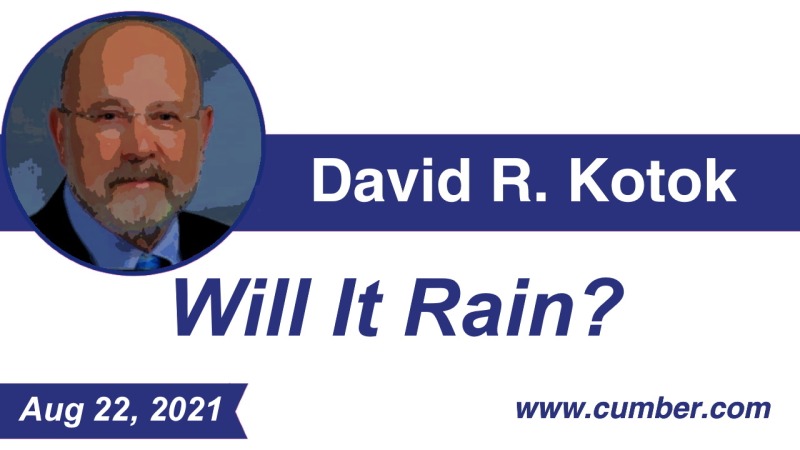A couple of months ago we offered readers an escape and talked about numbers (“An Economist Visits the Grand Canyon,” https://www.cumber.com/market-commentary/economist-visits-grand-canyon). My longtime friend and fraternity brother Frank M sent an extensive email question about his Seattle weather forecast, which you may find in that piece.

Here’s an excerpt from Frank’s question:
“Does anyone know if a 24% chance of rain means that 24% of a certain geographic area will have rain, or that there is really a 76% chance of everyone in the area staying dry? Or that there is a 100% chance of rain for some 14.8-minute block of time between 10 and 11?”
We put the question to Bob Bunting. Bob is CEO of the Climate Adaptation Center and a 35-year veteran on this subject. The Climate Adaptation Center is “an expert resource to inform government, academe, and the private sector so they can create the necessary adaptation strategies and actions to protect our Florida way of life. It provides support for the emergence of the Climate Economy.” You can read more about the CAC and how to support it at https://www.theclimateadaptationcenter.org/.
Bob wrote,
“In the weather business we forecast rain for later verification using an official rain gauge usually located at a National Weather Service office or some other officially designated location.
“In short, it is a point forecast, not an area forecast. We create, with our weather models, hourly forecasts like the one you are talking about.
“Let’s say, for example, there is a 50% chance for rain at noon. That means there is a 50% chance for .01 inches or more of rain, measured at the specific point where the rain gauge is located. If you get in your car and drive from 20 miles east of that rain gauge or 20 miles west of it between 11:40 AM and 12:20 PM, then you have a greater chance to have rain on your windshield, since you are covering an area that has rain falling at more than one point. So while the chance of rain is 50% at a single point, you may have a 100% chance of getting wet if you are on Interstate 75 driving though a 40-mile-wide area.
“Most people are in one place within an area and not moving around. A point forecast is therefore best in most cases. While we can’t measure every point with our rain gauge, what I can say is that a 50% chance for rain forecast 10 times for Sarasota County will usually actually equate to 5 times it rained in the official rain gauge at the airport and 5 times it did not. About half the county on average will indeed get measurable rain every time that forecast is made.
“Furthermore, weather forecasts today are the best forecasts of any kind.”
Bob’s last line there was tongue in cheek. He said to me, “I will put them up against any economic forecasts of almost any kind for accuracy and value!”
I agree with Bob about economists and their prognostications. Weather forecasting used to be the joke pointed to by economic forecasters. Now economists seem to have ascended to the top of the missed forecast list. At least with a weather forecast we can figure out when to carry an umbrella.
Thanks, Bob, for taking the time to explain weather forecasting methodology.
A Little More About Bob...
Learn more about Bob and his mission at the Climate Adaptation Center website: https://www.theclimateadaptationcenter.org


